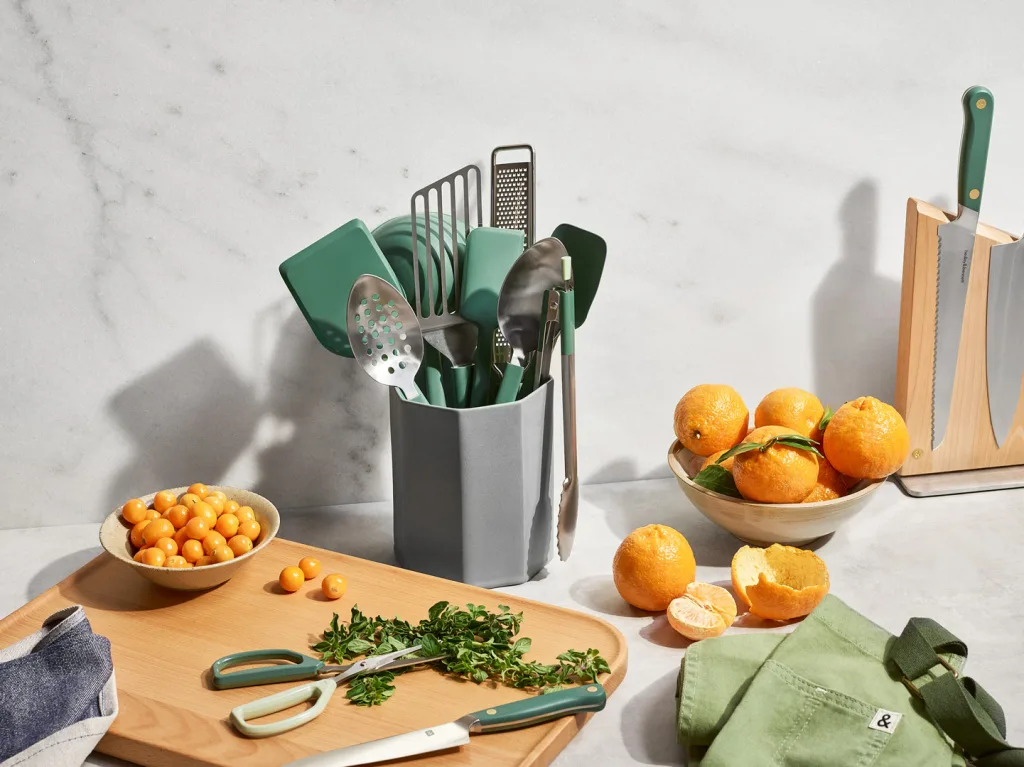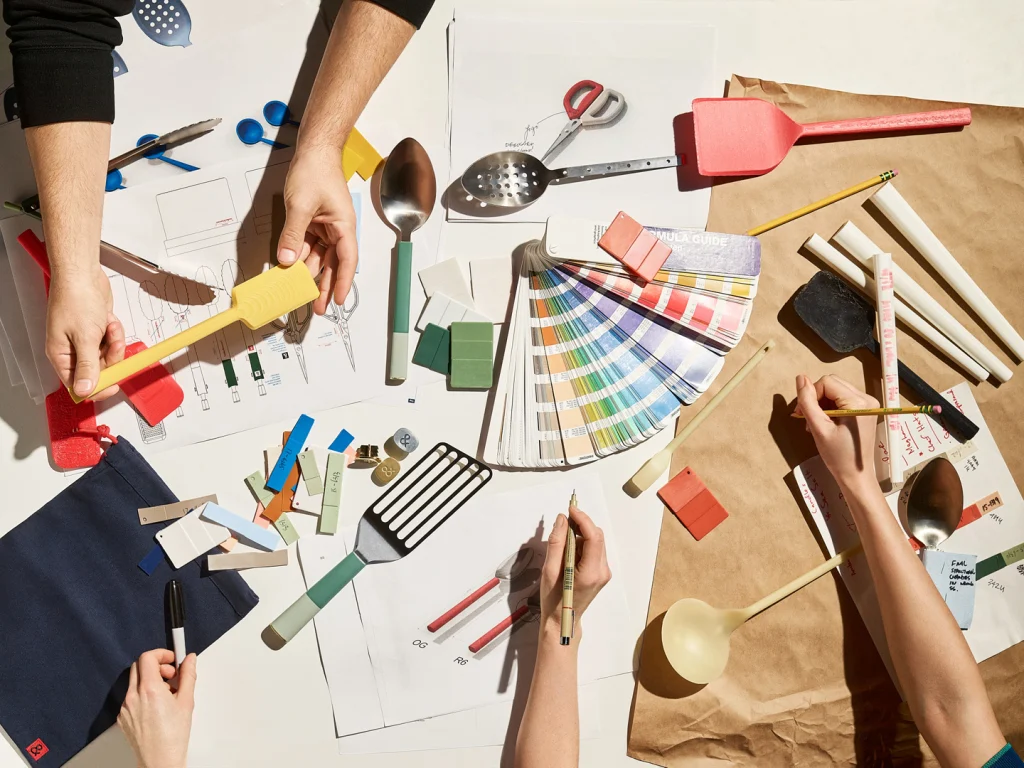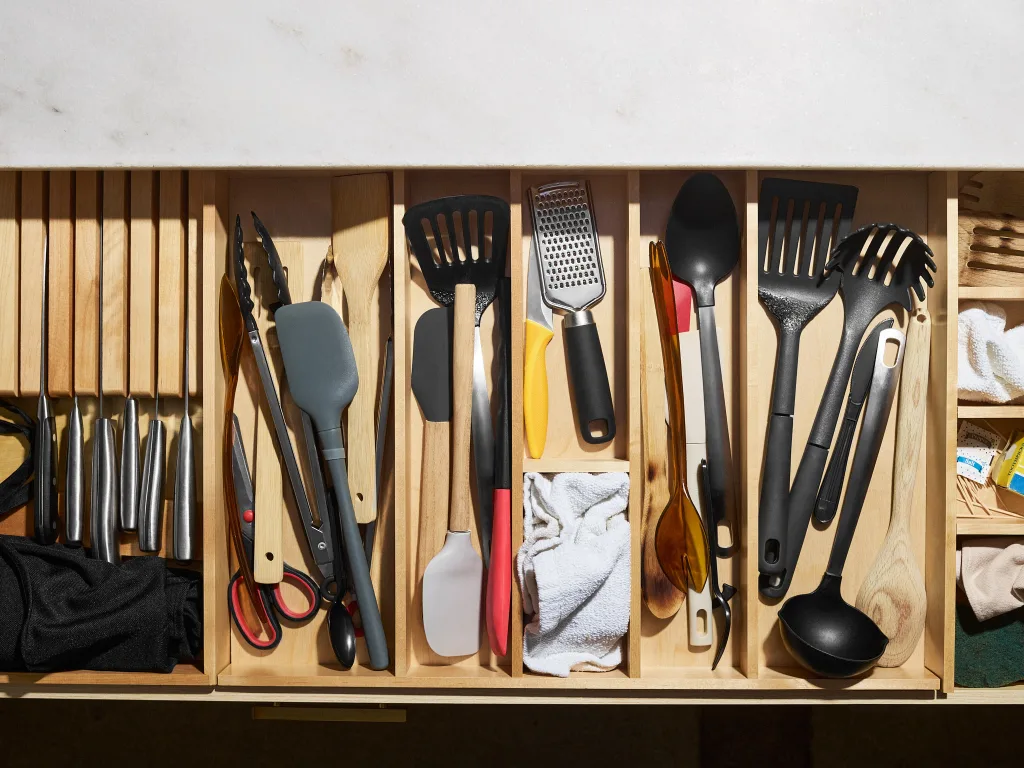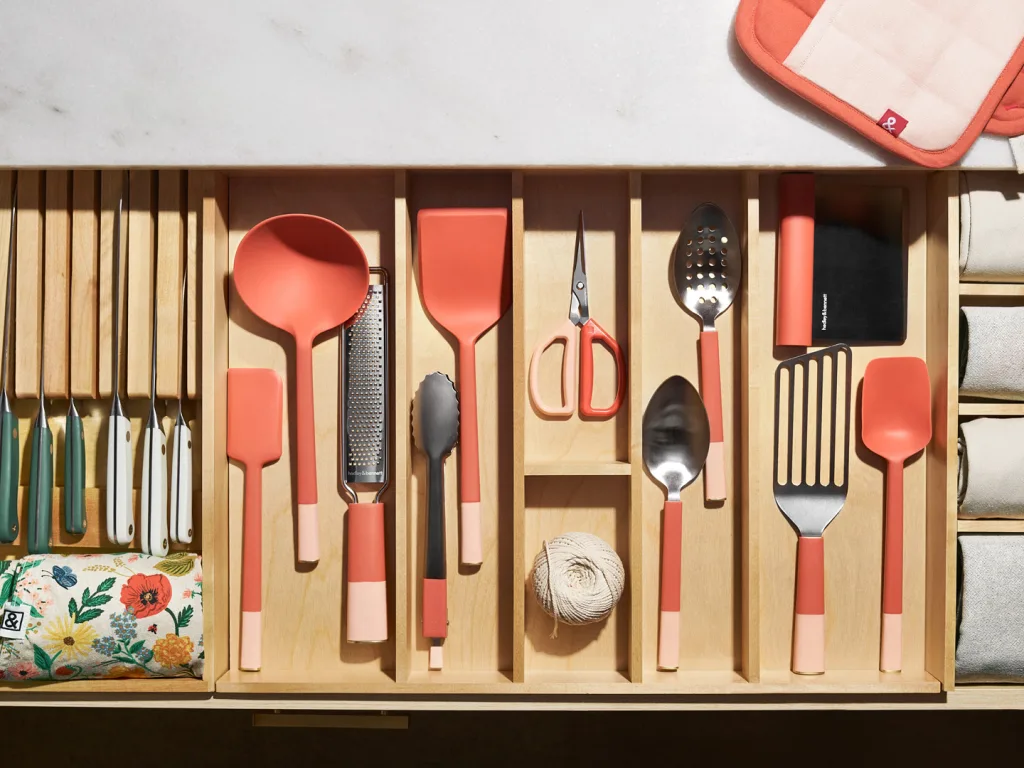Hedley & Bennett has a reputation. The company was founded by a chef who extensively and obsessively consulted other pros on the design of her signature offering: one of the most beloved kitchen aprons on the market today. The aprons have become ubiquitous in the restaurant and home-cook world, are sported by such folks as Alton Brown and Stephanie Izzard, and have even popped up on The Bear.
Accordingly, founder Ellen Bennett knew that if her company was going to expand beyond its cult-favorite duds and into kitchen tools—something they’ve been wanting to do for years—the stakes would undoubtedly be high.
Or to put it more bluntly: There was a lot on the line, and they knew they’d better not mess it up.
“You took the words right out of my mouth,” says Bennett.
Today, Hedley & Bennett is rolling out a suite of 11 tools designed for pros and home chefs alike: a ladle, a turner, a zester, two spatulas, tongs, a utility spoon, a slotted spoon, shears, a bench scraper and a spoonula (a hybrid of a spoon and spatula, a trendy item in kitchen gear at the moment). In an era of cheap, disposable cooking gear, the company took the slow route to production to build something with longevity.

A company grows
In 2012, as a young line cook, Bennett launched the brand, and she attributes her success to collaborating with professional chefs to design and perfect the apron. Consider her first order, which came from Bäco Mercat, where she worked. Bennett says Chef Josef Centeno complained that her aprons sucked because the neck straps kept falling down—so, she fixed the problem by overhauling the strap system into the adjustable thick webbing that is now the signature element of the brand.
“When you actually listen to your audience—really, really listen, get in the weeds and talk to them—you learn so much. They tell you everything you need to know,” Bennett says. “Even though we’re incredibly bigger than when we started out of my house with $300, that core philosophy will never go away, because it just keeps us honest, you know? There’s nothing like a chef telling you that something sucks for you to go back and redesign it.”

For a long while, Bennett says, the company was just focused on doing what it does best. But around the pandemic, they came to terms with the fact that they wanted to be a culinary brand—so they began mapping out a plan for what industry and home chefs would actually need.
At that point, their name had enough cache that they could have just turned to a private label and slapped some Hedley & Bennett stickers onto some wares, as other creators have done. Instead, they became industrial designers, making molds for every new product. “It is the painful, long, crazy route to take, but we knew we needed to do that to land where we wanted to land,” says Bennett.
First up were the most elemental tools of the trade: knives, which they worked with chefs to develop, and quietly launched online in 2022. When deciphering what came next, they took stock of their own kitchen drawers, filled with items they’d accumulated from all over the world. Then, they called in the pros, and also used Instagram to invite chefs to swing by the office to share their favorite gear.

They asked everyone to spill out their essentials onto a table, and they took stock of what the chefs loved—but also what they didn’t, and what could make their favorites even better. At the end of the day, Hedley & Bennett seized on the recurring themes and decided to move forward with three realms of product: established home classics (the spatula, turner, tongs, etc.); “IYKYK” essentials (the zester, fish spatula, shears and bench scraper); and an emerging favorite: the spoonula.
“It’s not just random choices we made,” Bennett says. “They’re actually anchored on lifetimes of experience.”
Chief Creative Officer Casey Caplowe says the team then did 3D prints of the tools’ handles and other elements, and the pros weighed in on the feel and specs, with Hedley & Bennett refining as they went along. After they made the leap to real production samples, they then went back to the chefs for field testing. Katianna Hong of Yangban was key to the project, as was the team at Caldo Verde.
At one point in the process, Bennett says Hong noted that the tools should all be shorter, as most drawers at home can’t accommodate kitchen gear as it is produced today.
“It hit me like a brick in the head,” Bennett says. “I’m like, She’s right, everything needs to be shorter. . . . These were the conversations that kind of made the journey so exciting and wild, because it would just take us on these windy curves. But everything was better because of it.”

KITCHEN NIGHTMARE
The other problem with the tools in our drawers at home: Too many of them are melted, especially if they’re made of nylon. Caplowe says being nontoxic was critical to the brand, so the materials had to either be wood, silicone (which doesn’t melt in regular kitchen use), or stainless steel. The team chose a mix of the latter two, which he added is a rare blend in the industry today. Moreover, he says silicone can affect tasting—so items like the spoons have stainless heads. When it came to the rest of the set, they assigned each material to its best use.

Just before the tools were set to launch last April, the team noticed that bringing those two materials together was causing problems. The ampersand-stamped brass end caps on the tools were starting to separate from the handles. So they paused the whole project for eight months and completely reengineered the interiors of the gear.

Ultimately, scaling has killed many a great restaurant. But Bennett says Hedley & Bennett is still hyper-focused on the obsession and quality that made their aprons a hit years ago—and, well, delaying a launch for months on end is perhaps a compelling testament to that fact.
“We’re not a tiny business anymore, but yet we still stick to that core root—and it’s kind of like, if something made you successful in the first place, you gotta continue doing that. You can’t let go of the thing that got you here in the first place.”